May in the Grand Canyon
Learn all about what it means to visit Grand Canyon National Park in May
Updated: 10/26/22
May in Grand Canyon National Park is when winter is definitively over and summer is beginning to appear. It’s a fantastic month to visit, hike, backpack, raft, to do it all, really. May 15 is when the North Rim opens, allowing visitors to hike Rim to Rim, either as a long day hike or as a multi-day backpacking trip or a Phantom Ranch visit. The summer crowds begin to appear in May, but the wonderful weather and sheer beauty of the place offset any inconvenience caused by increased visitation.
Benefits of Visiting in MAY
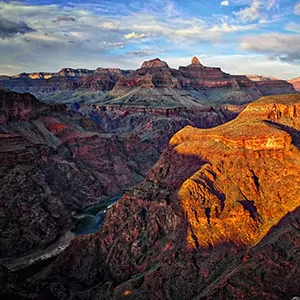 The biggest benefit of visiting the Grand Canyon in May is that the North Rim opens on May 15, allowing visitors to access that side of the Canyon, and to start embarking on the famous Rim-to-Rim hiking experience. The North Rim is much more remote than the South Rim and features a more quiet and slower feel, which many guests will love. It’s also famous for its stunning views that give a whole different perspective on the canyon as well as hiking opportunities with fewer crowds and on more remote trails. Fewer than 15% of the park’s visitors come to the North Rim but it is well worth a visit and May is the first month each year where you can access it by car and not only by foot from the trails that begin at the South Rim.
The biggest benefit of visiting the Grand Canyon in May is that the North Rim opens on May 15, allowing visitors to access that side of the Canyon, and to start embarking on the famous Rim-to-Rim hiking experience. The North Rim is much more remote than the South Rim and features a more quiet and slower feel, which many guests will love. It’s also famous for its stunning views that give a whole different perspective on the canyon as well as hiking opportunities with fewer crowds and on more remote trails. Fewer than 15% of the park’s visitors come to the North Rim but it is well worth a visit and May is the first month each year where you can access it by car and not only by foot from the trails that begin at the South Rim.
Another benefit of May is that it is prime time for rafting the Colorado River as the temperatures in the canyon have warmed up (but are not yet entirely baking) so it is refreshing to get splashed by the river’s icy water. Unlike later in the summer, May is typically fairly dry so you won’t have the monsoon season’s thunderstorms to threaten your rafting adventure by raising water levels or blocking side hikes. The temperatures on the rims are still relatively pleasant in May so sightseeing, bicycling, walking the overlooks, helicopter tours, and many other activities are almost perfect in May.
This one can be seen as a benefit or a drawback depending on if you were contemplating visiting earlier or later in the season: the crowds. May certainly has more crowds than earlier in the year as schools get out of session and people race to the park to catch the last few days of pleasant weather on the rims before summer is in full swing. But this month does not compare to the crowds that arrive in summer. So while you will probably find it busier than you would like, it won’t be the traffic and long line mania of summer in the park. May also afford guests great opportunities to see wildlife in the park. The reptiles (lizards and snakes) and amphibians (frogs and toads) are out of hibernation for the warmer weather and visitors often get glimpses of them in the streams or sunbathing on the rocks. Some of the park’s bigger animals such as elk, deer, and big horn sheep are also about this time of year. May is truly a great time to go to Grand Canyon and affords guests opportunities that do not come around as often in other months.
Drawbacks of Visiting in MAY
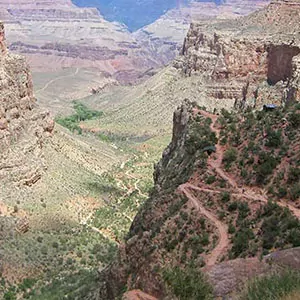 The biggest drawback of visiting in May is that the bottom of the Canyon begins heating up significantly. If you’re backpacking, hiking rim to rim, or hiking to Phantom Ranch, you can expect the highs to begin edging into the 90s. That’s the ambient air temperature in the shade – in the sun can feel much hotter. This leaves hikers with the threat of heat exhaustion or heat stroke, the latter of which can lead to coma or death if not treated. While May is not anywhere near the temperatures of summer, visitors can still be in danger of heat illnesses if they are not prepared. This leaves much of the canyon inaccessible as long hikes that stretch through the middle of the day are inadvisable due to the heat.
The biggest drawback of visiting in May is that the bottom of the Canyon begins heating up significantly. If you’re backpacking, hiking rim to rim, or hiking to Phantom Ranch, you can expect the highs to begin edging into the 90s. That’s the ambient air temperature in the shade – in the sun can feel much hotter. This leaves hikers with the threat of heat exhaustion or heat stroke, the latter of which can lead to coma or death if not treated. While May is not anywhere near the temperatures of summer, visitors can still be in danger of heat illnesses if they are not prepared. This leaves much of the canyon inaccessible as long hikes that stretch through the middle of the day are inadvisable due to the heat.
The other major drawback with May is that the summer crowds are beginning to appear. As mentioned above, they aren’t at summer levels yet, but it’s much busier than the winter months and even March and April. This makes trails crowded, roads busy and sometimes congested, and overlook parking lots full. At many national parks, the key to avoiding crowds in the summer is to go on a hike, but in Grand Canyon, long hikes to avoid crowds are not advisable because of the heat. This leaves guests crowded, especially during midday when the temperatures are at their hottest and the air-conditioned buildings are nearing capacity.
Another downside that comes along with the crowds is accommodations rates go up and availability goes down. With such an influx of visitors, the rates for hotels within the park skyrocket and are booked up months in advance. This makes planning a last-minute trip difficult if you want to stay within the park or within an hour or so from the park’s entrance as many of these accommodations will have been booked for months. It is best to reserve rooms or campsites at least the winter before your summer trip.
Things to Do in MAY
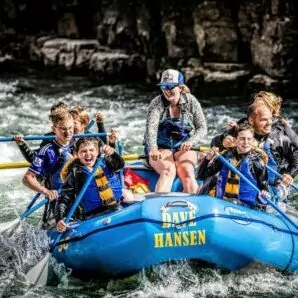 The two most highly recommended activities in May are hiking and doing a rafting tour. Hiking in May can still be done safely, but hikes should usually start around 6 am and be able to finish before the heat of the day in the afternoon. There are many short hikes around the rims where the temperatures are cooler than in the canyon and you can admire the views. Many of the trails down into the canyon such as Bright Angel and South Kaibab Trails have waypoints where hikers can decide to turn around. rim-to-rim hikes (hiking from one rim to the other via canyon trails) are on many people’s bucket lists, and these feats are quite an accomplishment.
The two most highly recommended activities in May are hiking and doing a rafting tour. Hiking in May can still be done safely, but hikes should usually start around 6 am and be able to finish before the heat of the day in the afternoon. There are many short hikes around the rims where the temperatures are cooler than in the canyon and you can admire the views. Many of the trails down into the canyon such as Bright Angel and South Kaibab Trails have waypoints where hikers can decide to turn around. rim-to-rim hikes (hiking from one rim to the other via canyon trails) are on many people’s bucket lists, and these feats are quite an accomplishment.
A rim-to-rim hike can be done as a day hike, but this is highly discouraged by the National Park Service, and shouldn’t be done unless you’re experienced and very fit. Grand Canyon weather and environment are not to be trifled with and heat exhaustion, heat stroke, water intoxication, and dangerous animal encounters are very real risks, all of which can lead to serious injury or death. You can do a rim-to-rim hike on a multi-day trip with a stay at Phantom Ranch (reservations are extremely competitive) or on a backpacking trip. This is by far the better option as you can rest during the middle of the day when the heat is most intense and enjoy more of the canyon as you won’t be rushing back up to the rim to beat the heat.
Rafting in the Grand Canyon is extremely popular in May as the hot (but not yet summer level) temperatures make getting splashed with the Colorado River’s frigid waters refreshing. Rafting the Colorado River can be done in as little as 6 days and is an experience you’ll never forget. Sightseeing and photography are also very popular options in May as the animals are out and about and the monsoon season has not yet started to cloud the canyon in the afternoons. Night sky photography is also perfect this time of year as the nights are not bitterly cold like they are in winter and most nights are clear for your milky way shot with the red rock canyon in the foreground.
If the weather is unusually hot or if you’re looking for a way to spend the heat of the day indoors, the Yavapai Geology Museum which has fantastic exhibits on the fossils and geology in the park, or the Kolb Studio and photo gallery are great options as well as the visitor center on the South Rim that has an excellent, 22-min film about the park and the surrounding area. Native American and early settler history is also available to see in the park at the Tusayan Museum and Ruin, Eagle Point Native American village on the west rim, or the Desert View Watchtower to the east. Hermit’s Rest which marks the end of Hermit’s Rest scenic drive is a great representation of a miner’s cabin and there are many other mining sites in and around the canyon that guests can visit.
A trip on the Grand Canyon Railway from the nearby town of Williams, a stroll on the Grand Canyon skywalk (a bridge made entirely of glass suspended nearly 4,000 feet above the canyon floor), or an all-American dinner at the famous and historic El Tovar restaurant are all major attractions to the area as well as a plethora of other locations outside the park such as Lake Powell, Horseshoe Bend, Sedona, and Flagstaff. There are nearly endless options for activities in Grand Canyon in May, so gear up for any adventure of your choosing.
Things see in may
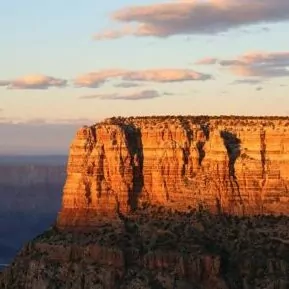 There are almost as many things to see in May at Grand Canyon as there are so do (and if you read the previous section you know that’s a lot). Sightseeing is one of the most popular activities in the park and May is one of the best times to do this. Winter storms obscuring visibility are only a memory and the afternoon thundershowers of monsoon season have not yet arrived. The biggest sight to see, the canyon itself, is dynamic and changes with light and angles throughout the day. This single gorge has a thousand different shades and hues from different viewpoints and overlooks. There is also a plethora of historical and archeological landmarks in the park that visitors can see and learn from.
There are almost as many things to see in May at Grand Canyon as there are so do (and if you read the previous section you know that’s a lot). Sightseeing is one of the most popular activities in the park and May is one of the best times to do this. Winter storms obscuring visibility are only a memory and the afternoon thundershowers of monsoon season have not yet arrived. The biggest sight to see, the canyon itself, is dynamic and changes with light and angles throughout the day. This single gorge has a thousand different shades and hues from different viewpoints and overlooks. There is also a plethora of historical and archeological landmarks in the park that visitors can see and learn from.
Hopi Point: This well-known overlook along Hermit’s Rest Scenic Drive is well worth stopping at to take in the fantastic views. You can’t drive your private vehicle down this road in the warmer seasons, so you’ll have to take the shuttle service or explore the trail on foot or with a bike. If you can spare the whole day, biking Hermit’s Rest Trail is a great option for a more relaxing trip instead of taking the shuttle bus. Hopi Point is one of the best places in the park for seeing the sunrise or the sunset splash brilliant colors on the canyon’s already colorful walls.
Fossils: The Grand Canyon is full of geological and archeological secrets, not the least of which is the abundance of fossils, mostly of marine creatures, hidden in the canyon walls. If you find a fossil, take a picture or make a drawing and show a ranger to see if you can identify it. If you want to see specific fossils, such as the famous tracks of an unknown and extinct reptile preserved in sandstone, you can ask a ranger where a good place is to find marked fossils or visit the Yavapai Geology Museum for more information.
Desert View Watchtower: Located near the east entrance to the park, this watchtower is seldom visited and even more seldom climbed. The work of famous architect Mary Colter, this tower seems to rise out of the very canyon walls itself. Inside the first level, you’ll find a replica of a Native American Kiva where cultural demonstrations are often performed while the upper floors feature spectacular views of the canyon. Make sure not to miss these beautiful sights, especially if you are coming into the park through the east entrance.
Tusayan Museum and Ruin: Near the east entrance to the park and the Desert View Watchtower lies the Tusayan Museum and Ruins, an estimated 800-year-old site of Native American Ruins. The people who lived here are thought to be the ancestors of the modern Pueblo and Hopi peoples and much of the history of these people can be found in the pottery and buildings that were left here. Take a self-guided walk or join a ranger-led tour around these amazing ruins and get a glimpse into what life was like for some of the first people who lived here.
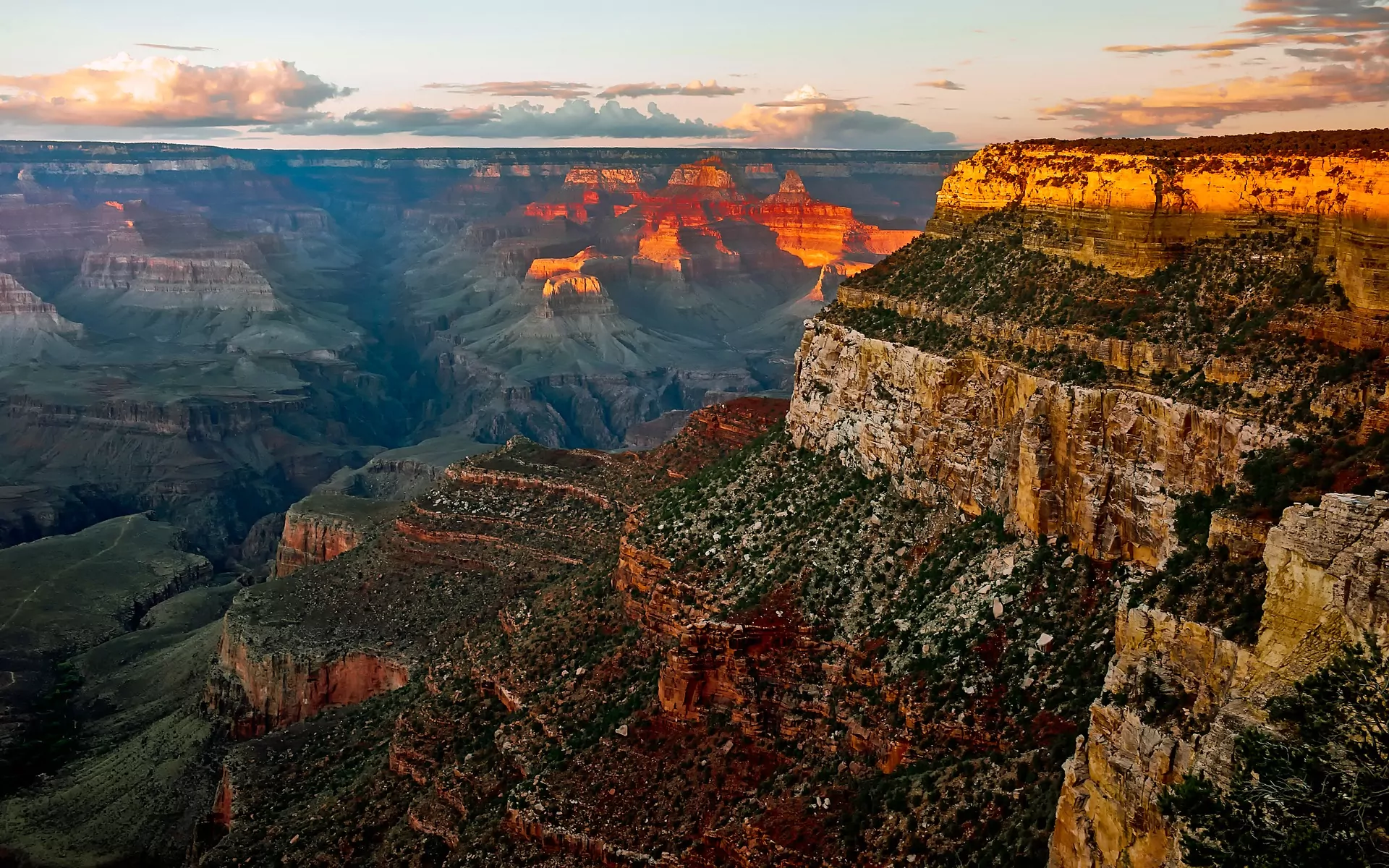
Hiking in MAY
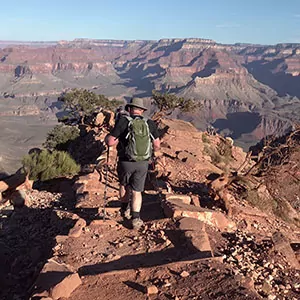 Although May is when the North Rim opens, and Grand Canyon’s most famous hike – the Rim to Rim – is possible, May is also when the summer heat becomes dangerous. With an average high of 92 degrees Fahrenheit in the shade, many routes in the Canyon become more dangerous for hikers who lack experience or are less than prepared. Day hikes that go 3 miles or less should be done with at least 3 liters of water per person and plenty of snacks and food, and they should start early (around 6 am.) Backpackers should try to avoid hiking in the middle of the day when it’s at its hottest, and be wary of hiking long stretches without enough water.
Although May is when the North Rim opens, and Grand Canyon’s most famous hike – the Rim to Rim – is possible, May is also when the summer heat becomes dangerous. With an average high of 92 degrees Fahrenheit in the shade, many routes in the Canyon become more dangerous for hikers who lack experience or are less than prepared. Day hikes that go 3 miles or less should be done with at least 3 liters of water per person and plenty of snacks and food, and they should start early (around 6 am.) Backpackers should try to avoid hiking in the middle of the day when it’s at its hottest, and be wary of hiking long stretches without enough water.
If you’re hiking Rim to Rim, you might consider sitting out the hottest part of the day at Bright Angel Campground, under the shade of cottonwood trees, and finishing your hike later in the day. The National Park’s Service does not recommend (and yet does not forbid) hiking rim to rim in one day. This hike is 24 miles (from one rim to the other)) and is incredibly strenuous and difficult. The added dangers of having to carry more water and food because of the heat, coupled with the steep trails and high elevation make this trek much safer if it is done in a few days instead of only one. Staying the night at the bottom of the canyon at Phantom Ranch or backpacking will allow you to be safer on the trail and enjoy the canyon more as you aren’t rushing to beat the heat up the canyon walls.
Guided hiking and backpacking tours are available in May, which is one of the most popular months of the year for such experiences. There are also many hikes along the rims which allow guests to stay at higher elevations where the temperature is cooler. Bright Angel and South Kaibab trails both have waypoints and overlooks that serve as markers for guests who do not want to hike all the way into the canyon. Doing a shorter hike of 1-3 miles in the morning or evening can be a great way to experience the canyon without as many of the risks of a longer trek on your own.
Hikers should be aware of the dangers they might encounter while on the trail and what they can do to prevent them. Heat exhaustion and heat stroke are the most immediate dangers, the latter of which can lead to death if not treated. Make sure you know the differences between these two conditions as heat stroke is a life-threatening emergency while heat exhaustion (though it can lead to heat stroke and thus is still dangerous) can be dealt with without emergency medical assistance.
The NPS has also seen an increase in water poisoning in the park. This condition is caused by an individual drinking too much water and throwing off the sodium balance in their bloodstream. To prevent this, hikers should eat plenty of salty snacks while on the trail along with drinking plenty of water. While many hikers chose to cool off in the frigid waters of the Colorado, currents can be strong and hikers should be careful not to be swept away by currents and rapids. May is still a great time in the park for hiking, but does come with some additional risks than earlier in the year. Going on a guided hike, even for just a day, is a great way to make sure you have all the safety information and an expert guide to show you around the canyon.
backpacking in may
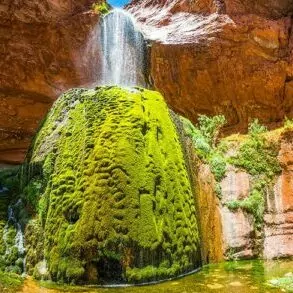 Backpacking in May is a very popular activity and many backpackers that cannot go earlier in spring chose May as the first time they can get off work or the kids are off school. Choosing to backpack in the canyon is a great way to see the park safely this time of year because the temperatures are too high to do extensive hiking in a single day. Backpacking allows you to get to places that you wouldn’t be able to day hike to and makes trips like the famous rim-to-rim trip safer and more enjoyable as you can sit out the heat of the day, take your time through the canyons, and possibly go on side trips. The weather at night at the bottom of the canyon is simply perfect and is usually just cool enough to make you want to get in your tent and drift off. If you’re looking to do a short trip, consider hiking to the floor of the canyon and just spending a night or two before coming back up to the rim. South Kaibab and Bright Angel Trail both descend all the way down into the canyon and will drop you off near Bright Angel Campground and Creek where you can set up camp for the next few nights. Havasupai Garden and the creek offer great chances to see a part of the canyon that isn’t entirely desert. You can also make this trip longer by adding a few nights in the same campground or moving further away from the frequently trafficked area of the canyon and setting up camp in a more remote location. Trekking from rim to rim is a famous hike for a reason and is simply spectacular. There are many itineraries to choose from and guiding companies offer guided trips on many of the trails. You can check out what guided trips are offered to see if you want to take a guided tour or just want to look at some sample itineraries for your own trip.
Backpacking in May is a very popular activity and many backpackers that cannot go earlier in spring chose May as the first time they can get off work or the kids are off school. Choosing to backpack in the canyon is a great way to see the park safely this time of year because the temperatures are too high to do extensive hiking in a single day. Backpacking allows you to get to places that you wouldn’t be able to day hike to and makes trips like the famous rim-to-rim trip safer and more enjoyable as you can sit out the heat of the day, take your time through the canyons, and possibly go on side trips. The weather at night at the bottom of the canyon is simply perfect and is usually just cool enough to make you want to get in your tent and drift off. If you’re looking to do a short trip, consider hiking to the floor of the canyon and just spending a night or two before coming back up to the rim. South Kaibab and Bright Angel Trail both descend all the way down into the canyon and will drop you off near Bright Angel Campground and Creek where you can set up camp for the next few nights. Havasupai Garden and the creek offer great chances to see a part of the canyon that isn’t entirely desert. You can also make this trip longer by adding a few nights in the same campground or moving further away from the frequently trafficked area of the canyon and setting up camp in a more remote location. Trekking from rim to rim is a famous hike for a reason and is simply spectacular. There are many itineraries to choose from and guiding companies offer guided trips on many of the trails. You can check out what guided trips are offered to see if you want to take a guided tour or just want to look at some sample itineraries for your own trip.
While backpacking this time of year is an amazing experience, it is important to be both mentally and physically prepared for hiking in extreme heat and dryness. Temperatures in the canyon can feel as though they are in the triple digits in May if you are in the sun and exerting yourself. It is important to take plenty of water as well as salty snacks to prevent dehydration and water intoxication (a condition when a person drinks too much water and throws off the sodium balance in their blood), both of which can lead to death. All the dangers that come with day hiking also come with backpacking so make sure to read the section above if you are interested in this activity. The canyon is at about 7,000 ft of elevation and the trails can be brutal and steep. Backpackers need to be sure that they can handle the trail that they chose. Talk to a ranger before setting out to see what the trail conditions are and if the trail is suitable to your experience level.
Weather in MAY
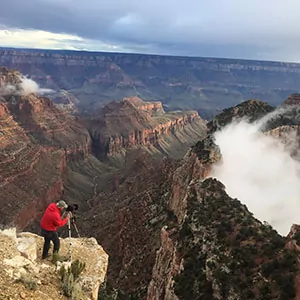 The Grand Canyon is a large park and the canyon itself creates unique weather patterns. The average high at the South Rim in May is 71 degrees Fahrenheit, and the average low is 36 degrees Fahrenheit (high of 22 degrees Celsius, low 2 degrees Celsius.) It’s only slightly colder on the North Rim with a high of 63 and a low of 34. Within the canyon, temperatures get higher, often by 10 to 20 degrees for ambient air in the shade, not including what some people call the “real feel”– the true feeling temperature.
The Grand Canyon is a large park and the canyon itself creates unique weather patterns. The average high at the South Rim in May is 71 degrees Fahrenheit, and the average low is 36 degrees Fahrenheit (high of 22 degrees Celsius, low 2 degrees Celsius.) It’s only slightly colder on the North Rim with a high of 63 and a low of 34. Within the canyon, temperatures get higher, often by 10 to 20 degrees for ambient air in the shade, not including what some people call the “real feel”– the true feeling temperature.
At Phantom Ranch at the bottom of the Canyon, the average high temperature in May is 92 degrees Fahrenheit, and the low of 63 degrees Fahrenheit (33H/17L degrees Celsius.) It rains on average only 2 days in May. Visitors should keep in mind that these temperatures are only averages and the park can experience much colder– or hotter– temperatures than this. May at the bottom of the Grand Canyon is the equivalent of summer for many places in the United States (although not the equivalent of real summer in the park). This leaves guests in a sticky situation when trying to pack for their trip. Even if you’re going to spend most of your time in the canyon, you’ll still need a jacket or two for the chilly nights up on the rim. You could probably leave it in your car though if you’re not planning on being out at night while in the canyon.
May is when the heat in the canyon begins to become dangerous and you will want to take precautions to keep you and your party safe. The intense heat, elevation, and dryness should tell all visitors that resting in the shade during the heat of the day is a good idea. Even if you are on a longer hike, waiting in the shade from noon to three pm can significantly decrease your chance of falling victim to heat exhaustion or heat stroke. Both of these conditions can be fatal (as heat exhaustion can lead to heat stroke) and it is very important to know the difference between them as the first is a “sit down and cool off” situation while the second is a life-threatening, medical emergency. As both of these conditions can cause disorientation and confusion, it is important to hike in groups for your safety and to make sure everyone knows the symptoms of these conditions.
Make sure to drink plenty of water as dehydration from the heat is a real risk. The National Park’s Service now recommends drinking water and eating plenty of snacks while on the trail or even leisurely enjoying the canyon as there has been a rise in water poisoning in the canyon. This happens when a person drinks too much water and disturbs the sodium balance in their bloodstream which can cause cells to swell. If this swelling happens in the brain, it can lead to serious injury or death. In order to combat this, it’s best to eat salty snacks along with drinking water to maintain your sodium balance. Make sure to check the forecast each day before you set out and to know that the temperatures in the sun will probably feel hotter than what the forecast said. May is one of the last months where you might still get some pleasant days in the 80s in the canyon, so make sure to get out there before the summer heat limits more activities.
Wildlife in may
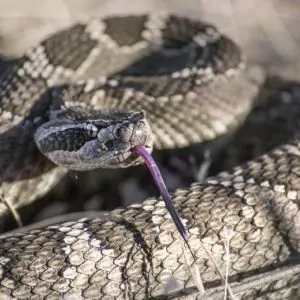 May is an excellent time to view wildlife as the Grand Canyon is full of biodiversity and wonderful creatures. From tiny lizards to the massive bison, there is plenty of wildlife to view. All the reptiles and amphibians are out of hibernation in May so you’ll be able to see lots of lizards and maybe even a snake or two on your hikes. Watch out for the park’s population of rattlesnakes sunbathing on the trails, however. These snakes do not always rattle before they strike out of self-defense, so watch your step as a bite can be fatal if you do not receive immediate medical attention.
May is an excellent time to view wildlife as the Grand Canyon is full of biodiversity and wonderful creatures. From tiny lizards to the massive bison, there is plenty of wildlife to view. All the reptiles and amphibians are out of hibernation in May so you’ll be able to see lots of lizards and maybe even a snake or two on your hikes. Watch out for the park’s population of rattlesnakes sunbathing on the trails, however. These snakes do not always rattle before they strike out of self-defense, so watch your step as a bite can be fatal if you do not receive immediate medical attention.
Elk and bison also inhabit the park (with bison only inhabiting the North Rim). These creatures are majestic and wonderful to see, but make sure to keep a distance of about 100 ft as these animals are wild and can be dangerous if they feel threatened. Even the rock squirrels that the park is famous for can be dangerous. If they are used to being fed by humans, they can become aggressive and approach you, sometimes being brave enough to steal the food off your table. Squirrels cause the most injuries to humans or any animals at the Grand Canyon, mostly resulting in scratches and bites when trying to steal food.
One of the most elusive animals in the park is notorious for worming its way into buildings in search of food, yet is careful to avoid detection and is strictly nocturnal. The ringtail, often called the ringtail cat, is probably the cutest animal you’ve never seen. Looking like a cross between a mouse and a red panda, these adorable creatures are closely related to raccoons and are only seen at night. They are sometimes seen around Phantom Ranch in the evening so keep your eyes peeled there if you want to see one.
\California condors, the biggest bird– and one of the rarest– native to North America has a population in the Grand Canyon. With a wingspan of up to 9.5 ft, these massive birds can often be seen soaring above the canyon walls, riding the updrafts of warm air rising from the canyon.
The park is also home to a large variety of creatures we haven’t mentioned here such as mule deer, bobcats, coyotes, toads, tortoises, mountain lions, and javelinas. Wildlife is most active at dawn and dusk because of the lack of crowds and the lack of heat. You won’t be disappointed if you spend some of your visit to the park looking for some of these creatures, so ask a ranger where you are most likely to see your particular animal or what has been caught recently on remote cameras.
Recommended wildland trips in may
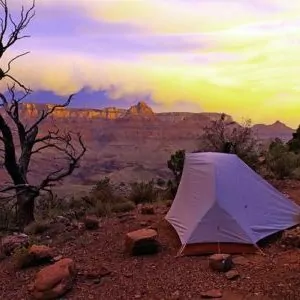 Planning any kind of trip to the Grand Canyon can be difficult in May as the weather begins to feel more like summer in the canyon and you may have to plan your trip with incomplete information about conditions and trails. But you can bypass all that headache by booking a guided trip with Wildland Trekking. Particularly backpacking trips in May and moving into the summer can make backpacking dangerous if you do not have the proper experience. But with our all-inclusive trips, you will have an expert guide who is well-versed in the area to make sure you aren’t missing any important safety information. We offer hiking tours for all levels of experience and comfort on the trail from backpacking treks and basecamp tours to inn-based trips and day hikes. Feel free to explore all the trips we offer in Grand Canyon but here are a few we especially recommend for May.
Planning any kind of trip to the Grand Canyon can be difficult in May as the weather begins to feel more like summer in the canyon and you may have to plan your trip with incomplete information about conditions and trails. But you can bypass all that headache by booking a guided trip with Wildland Trekking. Particularly backpacking trips in May and moving into the summer can make backpacking dangerous if you do not have the proper experience. But with our all-inclusive trips, you will have an expert guide who is well-versed in the area to make sure you aren’t missing any important safety information. We offer hiking tours for all levels of experience and comfort on the trail from backpacking treks and basecamp tours to inn-based trips and day hikes. Feel free to explore all the trips we offer in Grand Canyon but here are a few we especially recommend for May.
Grand Canyon Basecamp Tour: This 4-day camping tour begins with a hike on the South Rim before heading to the much more remote and wild North Rim for the remainder of the trip. Experience both the popular trails and little-known gems during the day hiking with only a light day pack and having your camp set up for you each night to return to. All-inclusive with meals, accommodation, local transportation, and much of your gear included, you won’t want to miss out on getting a taste of both rims on this tour.
Grand Circuit Inn Based: Get the perfect balance between adventure and luxury on this inn-based tour that will give you a taste of it all. Experience 2 hikes off the North Rim, 3 hikes off the South Rim, see Lee’s Ferry (the official beginning of the canyon), dripping desert oases, and stunning fossils. After all your adventures, relax each night at the lodge near the rim. We’ll take care of everything from reservations to accommodations, meals to transport. All you have to do is get ready for the adventure of a lifetime.
New Hance Loop: This backpacking tour in the Grand Canyon is no joke and is one of our most strenuous trips, but is well worth the fatigue. Journey away from the crowds into some of the most remote areas of the canyon near Horseshoe Mesa, desert oases, the stunning Red Rock Canyon, and the banks of the Colorado River. Enjoy solitude like a few other places in the park and focus on enjoying the journey while your expert guide takes care of all the details, meals, and itinerary.
Join a Guided Hiking Adventure
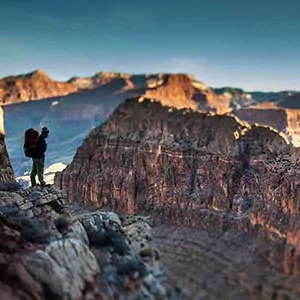 Grand Canyon National Park is home to some of the most unique and spectacular hiking vacations in the world. Wildland Trekking offers trips with stunning views, geologic history, and incredible hiking and backpacking for visitors who want to have an active, adventurous experience.
Grand Canyon National Park is home to some of the most unique and spectacular hiking vacations in the world. Wildland Trekking offers trips with stunning views, geologic history, and incredible hiking and backpacking for visitors who want to have an active, adventurous experience.
Guided Grand Canyon treks include permits, local transportation (excluded on certain tours), meals, gear, risk management systems, and professional guides, allowing guests to make the most of their visit to the Canyon, focus 100% on enjoying their experience, and do it all with an increased level of safety and comfort.
GRAND CANYON ADVENTURE TOURS
- GUIDED BACKPACKING ADVENTURES: these are for people interested in an authentic adventure deep in the Canyon’s wilderness.
- HORSE-ASSISTED TRIP: on this trip to the bottom of the Canyon, guests hike with light day packs and camp near the Colorado River.
- PHANTOM RANCH TOURS: this tour (limited dates) goes to the bottom of the Canyon where we sleep 1 or 2 nights in the Phantom Ranch Lodge 5 minutes from the Colorado River. Showers, A/C, heat…etc.
- ALL-INCLUSIVE HIKING PACKAGES: inn-based and camping-based hiking packages provide all-around hiking experiences of the Grand Canyon.
- DAY HIKE TOURS: maximize your day at Grand Canyon on a fully guided, award-winning hiking tour on one of the Park’s best trails.





